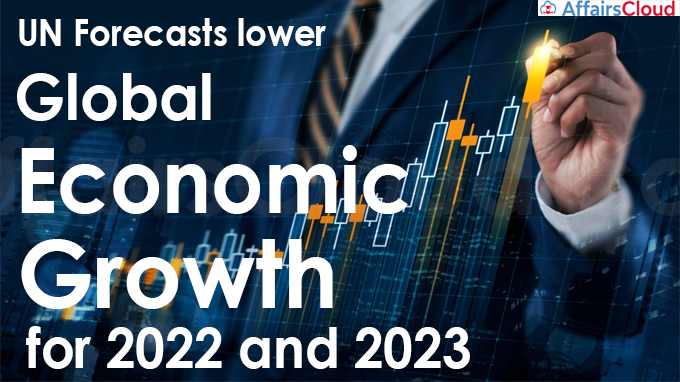
On January 13, 2022, the United Nations Department of Economic and Social Affairs (UN DESA) released World Economic Situation and Prospects (WESP) 2022 report was released which has lowered the global economic growth projections to 4% in 2022 and 3.5% in 2023 due to new waves of coronavirus infections, persistent labor market challenges, lingering supply chain issues, and rising inflationary pressures.
- Global trade in goods and services are forecasted at 5.7% in 2022 after an expansion of 11% in 2021.
- It should be noted that in 2021, the world economy grew at 5.5% due to consumer spending, some increase in investments and trade in goods which surpassed levels before the COVID-19 pandemic.
Who has produced the report?
It is produced by the UN DESA, in partnership with the United Nations Conference on Trade and Development (UNCTAD) and the five United Nations regional commissions: Economic Commission for Africa (UNECA), Economic Commission for Europe (UNECE), Economic Commission for Latin America and the Caribbean (UNECLAC), Economic and Social Commission for Asia and the Pacific (UNESCAP) and Economic and Social Commission for Western Asia (UNESCWA).
- The United Nations World Tourism Organization (UNWTO) also contributed to the report.
Indian front:
Before moving to India’s growth figure, please note that the growth of real Gross Domestic Product (GDP) in the region of South Asia is projected 5.9% in 2022 and 5.6% in 2023.
i.India’s Growth of world output and GDP is projected 6.7% in 2022 and 6.1% in 2023 as compared to 9% in 2021.
ii.By the second quarter of 2021, the Reserve Bank of India (RBI) was the only major developing country central bank continuing with significant asset purchases
iii.Inflation is expected to decelerate throughout 2022.
iv.India set a goal of reaching net-zero emissions by 2070 and ensuring renewable energy makes up 50 per cent of its energy mix by 2030
2023:
i.According to current forecasts, half of the world’s economies will exceed pre-pandemic levels of output by at least 7% in 2023.
ii.In East Asia and South Asia, average GDP in 2023 is projected to be 18.4% above its 2019 level, compared to only 3.4% in Latin America and the Caribbean.
- Despite a robust recovery, East Asia and South Asia’s GDP in 2023 is projected to remain 1.7% below the levels forecast prior to the pandemic.
iii.Africa, and Latin America and the Caribbean are projected to see gaps of 5.5% and 4.2%, respectively, compared to pre-pandemic projections.
Uncertainties and Risks:
i.The world growth started slowing down at the end of 2021 as the monetary stimulus impacts amid covid-19 started diminishing, and major supply chain disruptions emerged.
ii.Supply chain challenges and inflationary pressures are being faced by developed economies due to Labour shortages.
- While, rising food and energy prices are the factors behind rapid inflation, particularly in 9-member Commonwealth of Independent States (CIS), and in Latin America and the Caribbean.
iii.Recovery has been slow in tourism-dependent economies, mainly in the small island developing states.
iv.The number of people living in extreme poverty globally is projected to decrease slightly to 876 million in 2022 but is expected to remain 64 million above pre-pandemic levels (2019).
v.Limited access to vaccines poses challenge to most developing countries and transition economies as a resurgence of the virus will affect them more than the developed countries
- By December 2021, the number of vaccine doses per 100 people in the least developed countries stood at just 23.9 against 147.4 in the developed countries.
Click here for official report
Point to be noted:
i.Recently, the World Bank (WB) also downgraded its forecast of worldwide economic growth from 5.5% in 2021 to 4.1% in 2022 and 3.2% in 2023.
ii.World GDP in 2021 was 1.9% higher than in 2019 but still 3.3% below the level of output projected prior to the pandemic.
Recent Related News:
i.The Asian and Pacific Centre for the Development of Disaster Information Management (APDIM), the regional institution of the UN Economic and Social Commission for Asia and the Pacific (UN-ESCAP), has released the report on sand and dust storms named ‘Sand and Dust Storms Risk Assessment in Asia and the Pacific’. As per the risk assessments of the report, more than 500 million people in India are exposed to medium and high levels of poor air quality due to sand and dust storms.
ii.To resolve the global issue of Nutrition disparity, Countries should invest more on nature-based farming and providing incentives to small & medium scale farmers will play critical role in reducing rural poverty & increasing nutrition security, as per the ‘Rural Development Report 2021’ released by United Nations International Fund for Agricultural Development (IFAD), named “Transforming Food Systems for Rural Prosperity”.
About United Nations (UN):
Establishment– 1945
Secretary General– Antonio Guterres
Headquarters– New York, USA




